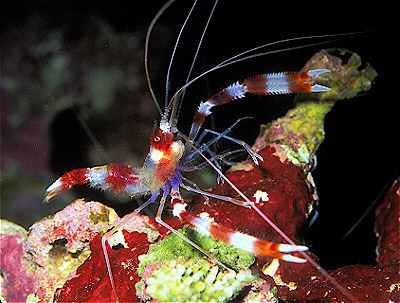Commensalism: Difference between revisions
| Line 24: | Line 24: | ||
3. Acropora nasuta and reef fish | 3. Acropora nasuta and reef fish | ||
From [[Corals chemically cue mutualistic fishes to remove competing seaweeds]], conducted by Danielle Dixon and Mark Hay for the National Insitute for Health | From [[Corals chemically cue mutualistic fishes to remove competing seaweeds]], conducted by Danielle Dixon and Mark Hay for the National Insitute for Health | ||
''Acropora nasuta'' coral is threatened by toxic seaweed, ''Chlorodesmis fastigiata''. The coral has evolved a chemical release to attract ''Gobiodon history or Paragobiodon echinocephalus'' to feed on this seaweed, while some gobies reside in the corals. The consumption of toxic seaweed makes the goby fish more toxic to predators. | |||
- coral goby cleans seaweed off corals, preventing the seaweed from taking up the coral’s source of sunlight | - coral goby cleans seaweed off corals, preventing the seaweed from taking up the coral’s source of sunlight | ||
- the toothy or common ghost goby seeks protection amongst soft corals in the Indo-Pacific ocean | - the toothy or common ghost goby seeks protection amongst soft corals in the Indo-Pacific ocean | ||
Revision as of 16:33, 25 February 2015
Commensalism
What is it?
A form of symbiosis "in which the symbiont benefits but there is an insignificant, or at least poorly known, effect on its host." [1]

Coral Reef Commensalism
While most example of commensalism in reef habitats occur between other species like fish and sea cucumbers or anemones, there are several instances of commensal relations between coral and shrimps and crabs that important to ecosystem function.
1. Pocilloporid and coral gall crabs
From Aspects of the groth and reproduction of the coral gall crab Hapalocarcinus marsupialis, conducted by Marine Science Department at Suez Canal University:
Coral gall crabs, Hapalocarcinus marsupialis, in the Indo-Pacific ocean are found hosted by the coral family pocilloporidae, genera pocillopora, stylophora, and seriatopora. These shrimp feed on mucus and tissue picked off the coral by host chelae. This hosting initiates gall development in corals up to 35 m in depth. This study focuses on the developmental and reproductive success of commensal versus non-commensal crabs.
Corals discharge up to 50% of the carbon byproduct from zooxanthellae as mucus. This mucus carries energy by dissolving into the water and filtering through lagoon sands. The mucus that does not dissolve catching floating particles and increases nutrient content in the reef community. This mucus contains light energy produced by the zooxanthellae, so the emission of this energy into the larger reef ecosystem is a natural example of a "recycling loop" (Christian et al).
There is no scientific evidence that suggests that the consumption of this mucus by the grabs is a significant depletion of resources, thus their relationship is a successful example of commensalism.
2. Petroglyph shrimp and Porites lobata
From A review of information upon the coral hosts of commensal shrimps of the sub-family Pontoninae original research by Kingsley 1878, review by A.J. Bruce at the Fisheries Research Station of Hong Kong
3. Acropora nasuta and reef fish
From Corals chemically cue mutualistic fishes to remove competing seaweeds, conducted by Danielle Dixon and Mark Hay for the National Insitute for Health
Acropora nasuta coral is threatened by toxic seaweed, Chlorodesmis fastigiata. The coral has evolved a chemical release to attract Gobiodon history or Paragobiodon echinocephalus to feed on this seaweed, while some gobies reside in the corals. The consumption of toxic seaweed makes the goby fish more toxic to predators. - coral goby cleans seaweed off corals, preventing the seaweed from taking up the coral’s source of sunlight - the toothy or common ghost goby seeks protection amongst soft corals in the Indo-Pacific ocean
References
Resources consulted:
http://ocean.si.edu/ocean-photos/coral-goby-cleans-coral
http://krupp.wcc.hawaii.edu/BIOL200/powerpnt/pdffiles/symbiosis.pdf
http://www.nature.com/nature/journal/v428/n6978/abs/nature02344.html
http://www.ncbi.nlm.nih.gov/pmc/articles/PMC3691814/
http://www.jstor.org/stable/pdf/1549739.pdf?acceptTC=true
http://decapoda.nhm.org/pdfs/25001/25001.pdf
- ↑ Sumich, James L. An Introduction to the Biology of Marine Life, Seventh Edition. WCB/McGraw Hill. 1999.